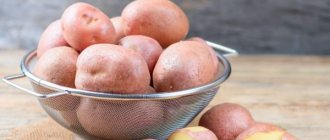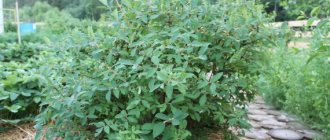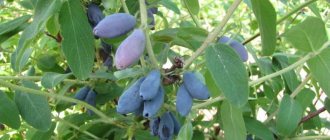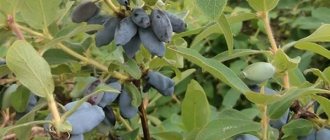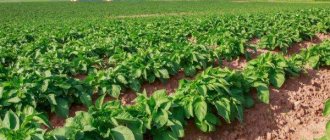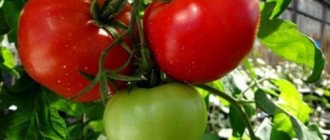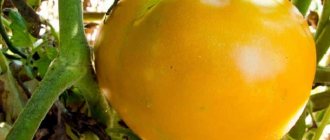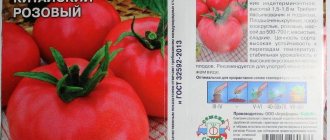Botanical description
Zest is classified as a medium-ripening variety; the plant has the following characteristics:
- the bush is medium-sized, slightly spreading;
- shoots are purple with pubescence, thin;
- leaves are light green, medium size;
- pale, medium-sized flowers;
- berries weighing about 1.1 g, 1.8–2.7 cm long;
- the shape of the berries is elongated-oval, the surface is bumpy;
- the color of the berries is blue, with a bluish coating, without pubescence;
- the pulp is fibrous, aromatic;
- the taste is sour-sweet, without bitterness.
The assessment of the taste of fruits by professional tasters varies significantly depending on the region in which the crop ripened. In the conditions of the northwestern regions of Russia it is 4 points, while in Ukraine it reaches 4.8 points out of 5 possible.
Photo of bush and berries
The photo of the honeysuckle variety shows a slightly spreading shrub. The leaves are medium-sized and light green. When flowering, the plant is covered with white flowers.
We recommend that you read How to prepare remontant raspberries for winter
The shoots are purple and thin. They have pubescence. Large honeysuckle fruits have an elongated oval shape. There are small tubercles on the berries. The fruits are characterized by a bluish-blue color.
Characteristic
Zest has many advantages, but there are also disadvantages that should be taken into account when choosing a variety.
Did you know? In addition to edible honeysuckle, there is also decorative honeysuckle, whose fruits are unsuitable for consumption. In total there are about 190 species of this creeping shrub. One of the most famous representatives of the culture with inedible fruits is wolfberry.
Frost resistance and drought resistance
This honeysuckle has demonstrated high frost resistance, but there is no information about how the variety tolerates drought.
Fruiting, productivity
Fruiting begins already in the 3rd–4th year of the plant’s life . The harvest in some regions begins as early as May, making honeysuckle one of the first berries of the season. The yield of the variety is low, but stable, and is about 27 c/ha or 0.9–1.4 kg per bush . The berries fall off the shoots weakly.
Advantages and disadvantages
- The main advantages of Zest can be considered:
- stable harvest;
- large tasty berries;
- non-shattering of fruits;
- frost resistance;
- disease resistance;
- unpretentiousness in cultivation.
Minor disadvantages of the variety include relatively low yield and the need for pollinators.
Reviews about growing honeysuckle Zest
Victoria, Omsk
Several honeysuckle bushes were planted on the site, including Izyuminka. They have been growing for 4 years, there were the first berries, but there are very few of them on all the bushes. We are not particularly worried, since the bushes also serve as a fence and bloom beautifully in the spring. We hope that we will be pleased with the harvest. On Izyuminka the berries are long, the taste is sweet and sour, pleasant. We only managed to try a little, we will wait for larger harvests.
Julia, Abakan
The raisin grows in the country, it was planted a long time ago, there was no special care. So, from time to time they trimmed the bushes so that they were not too dense. There are not many berries on them, we mostly eat them fresh. Honeysuckle was planted by my husband's father, more for beauty than for berries. At Izyuminka's, the berries fall off; if you don't pick them, half of them lie on the ground. I haven’t tried to cook anything from them, but my friends make jam and pastille, and it turns out delicious.
Landing Features
To provide the plant with the most comfortable conditions, it is necessary to select a suitable place for the plant and plant it at the optimal time.
Did you know? The bark of some types of honeysuckle peels off and exposes the trunk, which is why it received the popular name “shameless.”
Deadlines
Due to the early start of the spring growing season, it is advisable to choose the autumn period for planting. The optimal time is the end of September or the first week of October. If you need to plant a seedling in the spring, this should be done immediately after the soil has thawed, before the buds wake up.
Selecting a site, preparing holes
The place for honeysuckle should be bright and protected from the north wind . Since the plant reaches a significant size, it is necessary to provide enough space and support for an adult bush. An adult honeysuckle can reach a diameter of 1.5–2 m, so an area of approximately 2 × 2.5 m is allocated for it.
In general, the crop does not make any special demands on the soil, but it shows the best results on sandy and loamy soils with a slightly acidic reaction. The permissible groundwater level is 0.5 m. To plant one seedling, you will need a hole with dimensions of 40x40x40 cm.
Important! If the soil on the site is acidic, every 4 years it is necessary to add 200–300 g of lime per 1 m² of tree trunk circle.
To prepare the nutritional mixture you will need:
- 2 buckets of humus or compost;
- 200 g each of double superphosphate and potassium salt or 1-2 tbsp. ash.
This mixture is combined with the soil from the pit. The resulting nutrient soil fills the hole approximately 2/3.
Selection and preparation of planting material
The most suitable seedlings are two years old, which will allow you to get the first harvest in the next season. They should have 2–4 elastic shoots 30–40 cm long, as well as a branched root system. Before planting, seedlings are carefully inspected and damaged parts are removed. Long roots should be cut to 30 cm.
Planting scheme
The process of planting a seedling is carried out according to the following scheme:
- A mound of fertile mixture is formed at the bottom of the pit.
- A seedling is placed on a mound and its root system is straightened, checking that the roots do not bend upward.
- Fill the hole with earth and compact it. The root collar should ultimately be buried 3–4 cm.
- Honeysuckle is watered abundantly (about 10 liters of water per bush) and the trunk circle is mulched with sawdust, dry straw or humus about 4 cm thick.
Description of the honeysuckle variety Narymskaya
The first mention of edible honeysuckle appeared in the notes of the discoverer of Kamchatka, Vladimir Atlasov, in the 17th century. It was about sweet blue berries that local residents collected in wild forests in early spring. The first attempts to cultivate this plant date back to the end of the 19th and beginning of the 20th centuries.
Did you know? The famous biologist and breeder I.V. Michurin called honeysuckle a valuable and very promising berry.
History of selection
For regions with harsh climates, honeysuckle has become a godsend. This plant easily tolerates frosts down to -50°C, which is why most nurseries for breeding new varieties are located in Siberia and the Far East.
All known varieties of this crop come from its 5 wild ancestors:
- Altai;
- Kamchatka;
- edible;
- Turchaninova;
- Palasa.
Appearance, characteristics of berries, ripening time, yield
Narymskaya honeysuckle is a hemispherical bush. The lateral skeletal branches are directed widely to the sides. The bases of the shoots rise up to a height of 1.6–1.7 m, after which they form an arch and lower their edges to the ground.
The description of the berries is as follows: they are large, wide-spindle-shaped, weight - 1-1.3 g, length - 2.9-4 cm, diameter - 1-1.1 cm. The color is blue, they have a characteristic dense waxy coating. Dessert berries have a sweet and sour taste, and may have a slight bitterness if the summer is dry.
Chemical composition of berries:
- soluble solids - 16%;
- sugar - 8%;
- organic acids - 2%.
In addition, berries are rich in vitamins, macro- and microelements:
- magnesium - strengthens the nervous system, protects against stress;
- potassium - supports the functioning of the heart and blood vessels, normalizes blood pressure;
- iodine - helps with the functioning of the thyroid gland;
- zinc - improves the functioning of the gastrointestinal tract, helps wound healing;
- vitamin PP - improves memory;
- Vitamin C - needed to improve immunity and fight colds.
Important! Honeysuckle is contraindicated for gastritis with high acidity and peptic ulcers.
The Narymsky variety begins to ripen early, but not quickly, so it is classified as mid-early. Due to the density of the bush and the curvature of the branches, ripening is extended over time. Harvesting is recommended in two stages. Bushes 6–10 years old produce 2.5–4 kg of harvest per year. The shedding of berries is weak - up to 5–10%.
Advantages and disadvantages of the variety
Like any other, this variety has its advantages and disadvantages.
- The advantages are as follows:
- high frost resistance;
- unpretentiousness;
- ease of cultivation and harvesting;
- high productivity;
- minimal exposure to diseases and pests.
- There are also disadvantages:
- bitter taste of berries in dry years;
- The ripening of the crop is extended over time.
Rules of care
A feature of the culture is slow growth in the first 3–4 years after planting. So, in the 4th year the bush can reach only 1 m in height. This behavior should not be considered problematic; it does not require additional feeding or special pruning.
Find out how to properly transplant honeysuckle to a new location.
Watering and mulching
Active growth of crop shoots lasts only about 10 days and stops at the beginning of summer. Such an early start requires attention to the plant during this period. The mouth requires regular watering until fruiting is complete. Lack of moisture these days will significantly reduce the yield, reduce the size and worsen the taste of the berries. After watering, to preserve moisture and reduce the number of weeds, the tree trunk circle must be mulched.
Feeding
With a sufficient amount of fertilizer in the planting hole, the plant will not need other fertilizing for 2 years. As soon as the bush has begun to bear fruit, with the onset of spring, nitrogen fertilizer (ammonium nitrate or urea) should be added, diluting 30 g in 10 liters of water and pouring 1–1.5 liters of solution under the bush.
A solution of mullein (1:6) or bird droppings (1:10) is also often used. It is recommended to maintain an interval of 14 days and stop feeding in early July. When the crop has already been harvested, a solution of nitroammophoska or nitrophoska is added at the rate of 25–30 g per bucket of water. A solution of slurry (1:4) is also suitable.
In autumn, the following mixture is recommended for the bush (per 1 m²):
- 5 kg of compost;
- 100 g ash;
- 40 g double superphosphate.
Growing the Izyuminka variety: what to look for
Agricultural technology includes standard techniques that even beginners can easily master.
How to choose seedlings
When purchasing honeysuckle seedlings, pay attention to the condition of the shoots; they must be healthy and without deformation. It is advisable to purchase bushes with closed roots (growing in pots, containers), these take root faster and adapt to new conditions. Plants with bare roots are soaked in compositions with growth stimulants before planting.
Preparing the landing site
In shaded areas, honeysuckle bears fruit poorly, and Izyuminka is no exception. Only well-lit places with fertile soil are suitable for planting. Lowlands, areas with close groundwater, and acidic soil are not the best places for this crop. And if the acidity situation can be corrected by adding ash and dolomite flour, then in low-lying areas you will have to build a drainage system.
The best time for planting is autumn, since honeysuckle begins a dormant period in August. In spring it starts growing early, so spring planting will not be successful. Prepare the soil in advance and apply the necessary fertilizers:
- humus;
- wood ash;
- superphosphate.
You can do it differently: prepare a nutrient mixture from these components and add it to the holes before planting.
ON A NOTE!
Experts recommend giving priority when planting, as well as in subsequent fertilizing, to organic matter rather than mineral fertilizers.
You may be interested in: Secrets of growing goji in the open ground and features of caring for the shrub. What is yoshta, what are the benefits of the berry and how to grow a shrub in the open ground Edible honeysuckle: planting and caring for the plant
Hole dimensions: 40x40 cm, distance between bushes - 1.5 meters. After planting the seedlings, the soil is spilled with warm water and the soil is mulched.
Agricultural technology
In the first years, honeysuckle grows slowly, as the roots grow, and the above-ground part lags behind slightly. At this time, care comes down to watering, loosening, and weeding. There is no need to fertilize the bushes; the fertilizer applied during planting is sufficient for honeysuckle for two years.
Water in hot weather, monitoring soil moisture levels. The culture is considered moderately moisture-loving; fruit-bearing plants require more moisture.
In the third year, fertilizing and pruning are added to the listed techniques. The feeding scheme is simple:
- in the spring, feed honeysuckle with organic matter (humus, compost, diluted mullein);
- in summer - ash infusion;
- In the fall, potassium and phosphorus fertilizers (superphosphate, potassium salt, ash) are applied.
Fruit-bearing plants also need fertilizing after picking berries, so it is advisable to add 1-1.5 buckets of humus to each bush.
The peculiarity of Izyumina is the rapid growth of the bush, which is typical for honeysuckle. Without thinning, there is a high risk of thickening, which leads to a drop in yield and a sloppy appearance of the berry gardens.
Thin out the plants in the fall, when honeysuckle is dormant. All non-bearing, old, and weak shoots are removed. Sanitary pruning includes the removal of diseased and deformed shoots.
After 6-7 years, all bushes are rejuvenated. Some gardeners cut off all honeysuckle shoots completely, leaving 40-50 cm stumps. Others use the method of gradual rejuvenation of the Zest, cutting off 2-3 old branches and leaving the same number of young shoots. The total number of large and strong fruit-bearing shoots in a bush should not be more than 5-6 pieces.
Unlike many berry bushes growing in the middle zone or regions of Siberia, the Urals, and the European North, honeysuckle is not “afraid” of sub-zero temperatures and does not require special shelter for wintering. The root system of the plant can withstand severe frosts; the ground part does not freeze even in cold winters. There is no danger to the flowering crop during recurrent frosts; honeysuckle is accustomed to such “vagaries” of the weather.
ON A NOTE!
Honeysuckle adapts well to new living conditions, quickly adapts to the climate, and gardeners usually do not have any particular difficulties in caring for it.
Even when the upper part of the shoots freezes (usually this happens in winter, when the thaw abruptly gives way to frost), they quickly grow back.
If you want to propagate the variety, cuttings and layering are used. In the middle zone, gardeners also use bush division; only honeysuckle, the age of which does not exceed 5-6 years, is suitable for this procedure.
To prevent diseases and protect against pests, bushes are sprayed with special compounds:
- infusion of wood ash;
- green soap solution;
- Bordeaux mixture.
Since the honeysuckle harvest ripens early, chemical treatments are not carried out in the spring. They use folk remedies, and “chemistry” is used only in case of serious lesions. For aphids, honeysuckle is treated with solutions of Nitrafen, Karbofos, for leaf rollers - with Decis, Aktara.
ON A NOTE!
Aphids are spread on the site by garden ants. To kill insects, birds are attracted to the garden and garden by hanging feeders and birdhouses.
The berries are collected in June, as they ripen. You can’t keep the berries on the bushes too long; they will fall off and the harvest will be lost.
Honeysuckle Izyuminka is a winter-hardy variety successfully cultivated by gardeners in different regions of the country. It is valued for its large, tasty berries, easy care, and unpretentiousness to climatic conditions.
Harvesting and storage
The berries are collected after reaching full color. The raisin practically does not fall from the bush, so after gaining color you can wait about 7 days. The berries are collected in small containers in 1–2 layers.
Honeysuckle will keep in the refrigerator for about 3 days. It is suitable for freezing and drying, and is also used for making jam and other preparations.
Preparing for winter
The crop tolerates temperature drops down to -50°C without significant losses, and in the flowering phase it will also survive return frosts down to -8°C. Moreover, if prolonged warming occurs in winter, the plant may wake up and open fruit buds, which will be damaged by returning severe frosts. Despite this, additional cover for the bush is not used; only mulching of the root system is used.
To obtain a full harvest and keep the bush healthy, it is recommended to perform the following measures:
- remove all fallen leaves and, if necessary, prune the plant, and also remove the organic mulch used during the season in the tree trunk circle;
- cover the ground under the bush with a new layer of mulch.
Reproduction methods
It is quite easy to propagate honeysuckle. Usually, cuttings, layering or the method of dividing the bush are used for this. The seeds also sprout well, but they do not retain the varietal characteristics of the mother plant. Seed propagation is mainly used in breeding work.
Important! When planting by dividing the bush, honeysuckle shoots must be cut by a third.
Cuttings
Cuttings should be prepared in early spring, before the buds open. For them, strong annual shoots with a diameter of at least 7–8 mm are selected. There should be 2–3 buds on the cutting; about 3 cm is left for penetration into the soil, so the final length of the cutting is about 7–12 cm. The cut cutting is soaked for a day in water with the addition of a rooting agent; small cuts can be made on the bark on the lower part.
Lignified cuttings are cut in the fall, after leaf fall. For them, shoots of annual growth are selected, which, after cutting, are stored in the basement, in damp sand, until spring. When they are planted in spring, only 1 bud is left on the soil surface.
For rooting, it is best to use a peat-sand substrate in equal parts. You can plant the cuttings in a garden bed or in a small greenhouse. In any case, the planting should be covered with film or other material. The average time for rooting is approximately 1 month.
By layering
This is the easiest way to get several new bushes for your garden plot. In early spring, while the plant is still dormant, several shallow cuts are made on the bark of a low-lying horizontal shoot. The shoot is bent to the ground and fixed, then buried and watered. After rooting, the shoot is separated from the main plant and transplanted to the selected location.
If there are no shoots below, use the “air layering” method. From the top of the annual growth, remove a layer of bark (in the form of a ring 1 cm wide), 15–20 cm from the top, and cover the cut with damp moss. Then they wrap this place with film and secure it with tape. When root formation occurs, the cuttings are cut off and transplanted into the ground.
Dividing the bush
Honeysuckle that has reached the age of 6 years is suitable for this method. The plant is dug up in early spring, before the buds open, or in the fall, with the beginning of the dormant period. The bush is divided with a tool with a sharp blade, and the cut site is disinfected. Parts of the bush are planted in prepared planting holes and watered abundantly.
Diseases and pests
Honeysuckle is quite resistant to disease, but under unfavorable conditions it can become sensitive to powdery mildew and various spots, drying out and some other fungal diseases. To treat them, it is recommended to use early spring treatment with a solution of copper sulfate, Fundazol (2%) or Topaz. The culture practically does not suffer from viral diseases.
The plant's resistance to pests is also high, but the bush can be attacked by honeysuckle fingerfly, honeysuckle aphids, scale insects, leaf rollers and other pests. To combat them, after harvesting the fruits, the bushes are treated with a solution of Karbofos (0.3%) or Chlorophos (0.2%).
Among the special drugs we can recommend:
- “Decis”, “Eleksar” or “Inta-Vir” - against leaf-eating pests;
- "Aktellik", "Confidor" or "Rogor-S" - from sucking insects.
It is recommended to have healthy and tasty honeysuckle fruits in every garden. The Izyuminka variety can be grown in all regions of the country due to its high frost resistance. Its berries have an attractive appearance and taste, and the unpretentiousness of the crop in care will appeal to most gardeners.
